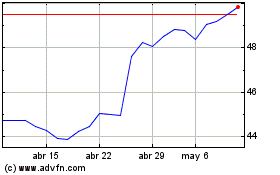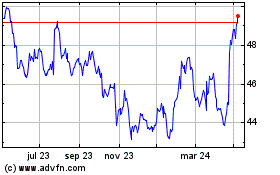Unilever Shows Unrivaled Gains -- WSJ
02 Febrero 2018 - 2:02AM
Noticias Dow Jones
By Saabira Chaudhuri
This article is being republished as part of our daily
reproduction of WSJ.com articles that also appeared in the U.S.
print edition of The Wall Street Journal (February 2, 2018).
LONDON -- Unilever PLC bucked a trend roiling its American
rivals by selling more products at higher prices during last year's
final quarter.
Consumer-goods giants Procter & Gamble Co., Kimberly Clark
Corp. and Colgate-Palmolive have reported weak sales as
brick-and-mortar retailers like Walmart Inc. push for steep
discounts as they compete with Amazon.com Inc. and as input costs
rise. P&G, the maker of Tide detergent and Pampers diapers,
last week said that average prices on its products fell in the most
recent quarter for the first time since 2011.
Unilever reported 0.7% growth in prices for the fourth quarter
on the back of volume growth of 3.2%. Overall, sales grew 4% on an
underlying basis -- which excludes acquisitions and disposals and
the effect of currency moves -- to EUR12.8 billion.
Unilever's focus on emerging markets, coupled with a portfolio
that includes high-end skin-care products and fancy mustard, means
the company has more of a buffer from price pressures than its
rivals, Unilever finance chief Graeme Pitkethly said in an
interview.
"We have less reliance than our rivals like P&G on
categories under pressure like razor blades and diapers," he said.
"We see the same trends but we don't see the same impact."
The company in 2014 created a prestige division and has since
acquired a string of premium skin-care brands, among others, to
strengthen this unit.
Mr. Pitkethly says he thinks Unilever will continue to push
through higher prices in North America in 2018, but warned that as
the company's e-commerce sales grow, price pressures will mount.
Unilever currently makes about 5% of its North America sales
online, and that segment is growing at 50%. "That brings the
pressure on," Mr. Pitkethly said.
While Unilever often has achieved sales gains by raising prices,
for the fourth quarter the company's volume growth impressed
analysts. Investors generally perceive price-led sales growth as
inferior to that driven by recruiting more customers or just
selling more to existing ones.
"This is a much-improved performance from Unilever," said RBC
analyst James Edwardes Jones.
For the year, Unilever reported its sales grew 1.9% to EUR53.72
billion, or up 4.9% on a constant-currency basis. Net profit for
the maker of Magnum ice cream and Dove shampoo grew 17% to EUR6.05
billion.
Like rivals, Unilever has been grappling with various headwinds.
Consumers in big, developed markets are increasingly opting for
niche brands they see as more desirable. In emerging economies,
increased competition is coming from increasingly sophisticated
local players, while at the same time big markets like India and
Brazil are suffering macroeconomic disruptions.
The tumult in the sector has attracted activist investors like
Nelson Peltz to P&G and Daniel Loeb to Nestlé SA, and created
an opening for Kraft Heinz Co. last year to approach Unilever with
an unwelcome $143 billion acquisition bid. Since then, Unilever has
agreed to sell its spreads arm, where sales growth has long been
declining. It also has launched a share buyback, set a new
operating margin target of 20% by 2020 and sought ways to simplify
its dual-listed structure, which holds it back from making big
acquisitions.
Unilever also has embarked on a companywide restructuring to
become more responsive to local trends, including giving increased
autonomy to its local managers. It made 11 acquisitions in 2017,
including buying hair- and skin-care company Sundial Brands in the
U.S.,and organic herbal tea brand Pukka Herbs in the U.K.
The company launched five new personal-care brands last year,
including Hijab Fresh -- a shampoo aimed at Muslim women that wear
head coverings -- and Love, Beauty and Planet -- an eco-friendly
hair and body-care brand aimed at millennials.
On Thursday, the company's home-care arm reported underlying
fourth-quarter sales growth of 6.5%, while personal-care sales grew
of 4.4%. The foods business saw sales rise 1.4%, and refreshments
-- which houses tea and ice cream -- rose 4%. After being
challenged by rival HaloTop in the U.S. Unilever's ice cream sales
returned to growth in the fourth quarter.
For the year, Unilever reported an underlying operating margin
of 17.5%, up 1.1 percentage point from 2016.
Unilever gave annual guidance of underlying sales growth of 3%
to 5% and an improvement in its underlying operating margin, as it
takes aim at its 2020 target.
Write to Saabira Chaudhuri at saabira.chaudhuri@wsj.com
(END) Dow Jones Newswires
February 02, 2018 02:47 ET (07:47 GMT)
Copyright (c) 2018 Dow Jones & Company, Inc.
Unilever (EU:UNA)
Gráfica de Acción Histórica
De Mar 2024 a Abr 2024

Unilever (EU:UNA)
Gráfica de Acción Histórica
De Abr 2023 a Abr 2024
